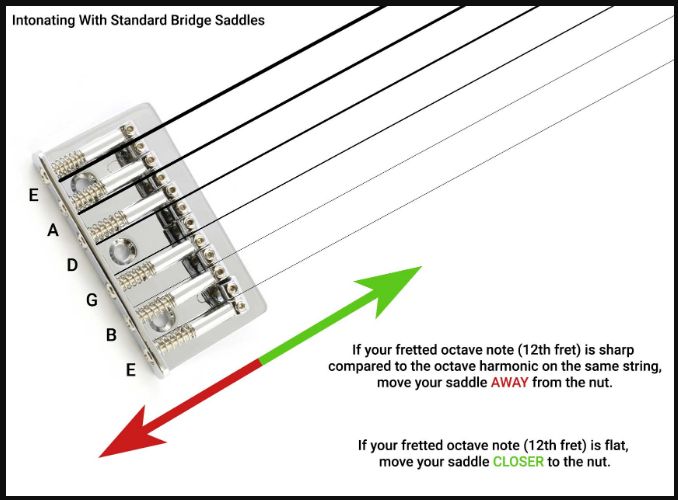How to set your intonation correctly and always play in tune
In this guitar lesson I go over everything you need to know about setting your intonation on any guitar. It works for hard tails, tune o matics, floyd rose, all bridges. You will use this information for the rest of the time you play on your gibson, fender, Ibanez, or any guitar.
https://www.youtube.com/watch?v=3phxqPP9UTU
See also https://www.electricherald.com/how-to-intonate-a-guitar-or-bass/
===
Setting intonation correctly on a stringed instrument, such as a guitar or a bass, is crucial for ensuring that the instrument plays in tune across all frets and strings. Here’s a step-by-step guide to help you set intonation correctly:
1. Tune Your Instrument: Begin by tuning your instrument to standard tuning using a reliable tuner. Make sure all strings are properly tuned to their respective pitches.
2. Check Open String Pitch: After tuning, play each open string individually and ensure that it matches the correct pitch. Use your tuner to verify that each string is in tune.
3. Check 12th Fret Harmonic: Next, play the harmonic at the 12th fret on each string. The harmonic should produce the same pitch as the open string but at a higher octave. Check the pitch accuracy with your tuner.
4. Compare 12th Fret Harmonic to Fretted Note: Now, fret each string at the 12th fret and play the note. Compare the pitch of the fretted note to the pitch of the 12th fret harmonic. They should be the same if your intonation is set correctly.
5. Adjust Bridge Saddles: If the fretted note at the 12th fret is sharp (higher in pitch) compared to the 12th fret harmonic, your string length is too short, and you need to move the bridge saddle back (away from the neck). If the fretted note is flat (lower in pitch), your string length is too long, and you need to move the bridge saddle forward (towards the neck).
6. Repeat and Fine-Tune: Repeat steps 3 to 5 for each string on your instrument. Make small adjustments to the bridge saddles as needed until the pitch of the fretted note matches the pitch of the 12th fret harmonic.
7. Re-Tune and Re-Check: After adjusting the intonation, re-tune your instrument to standard tuning and re-check the open strings and 12th fret harmonics to ensure that all strings are in tune across the fretboard.
8. Play and Test: Once you have set the intonation correctly, play some chords, scales, and melodies across different frets and strings to ensure that your instrument plays in tune across the entire range.
By following these steps and making precise adjustments to the bridge saddles, you can ensure that your instrument’s intonation is set correctly, allowing you to play in tune consistently across all frets and strings. If you’re unsure about making these adjustments yourself, consider seeking assistance from a professional guitar technician or luthier.
